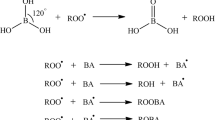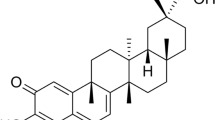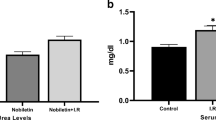Abstract
Objectives
To study the possible renoprotective effect of sildenafil against renal ischemia/reperfusion (I/R) injury and its effect on the expression of some antioxidant, antiapoptotic gene and proinflammatory cytokine genes in rat model of renal I/R injury.
Materials and methods
One hundred and twenty male Sprague Dawley rats were subdivided into three equal groups: sham (underwent right nephrectomy without ischemia), control (underwent right nephrectomy and left ischemia for 45 min) and study [as control with 1 mg/kg sildenafil (per oral) 60 min before anesthesia]. Serum creatinine and BUN were measured at the baseline and the study endpoints (2, 24, 48 h and 7 days), and the left kidney was harvested at study endpoints for histopathological examination as well as for assessment of the expression of antioxidant genes (Nrf-2, HO-1 and NQO-1), antiapoptotic gene (Bcl-2) and inflammatory cytokines, e.g., TNF-a, IL-1β and ICAM-1.
Results
I/R caused significant increase in serum creatinine, BUN, histopathological damage score (p < 0.001) and significant reduction in antioxidant genes (nrf2, HO-1 and NQO-1) and antiapoptotic gene (Bcl2) with significant increase in TNF-a, IL-1β and ICAM-1 genes in kidney tissues. Pretreatment with sildenafil caused significant attenuation of serum creatinine and BUN as well as significant increase in the expression of antioxidant genes and Bcl-2 genes with significant reduction in the expression of proinflammatory cytokine genes (p value < 0.001).
Conclusion
The renoprotective effect of sildenafil against renal I/R might be due to the activation of antioxidant genes (Nrf2, HO-1 and NQO-1) and antiapoptotic gene (Bcl2) and attenuation of proinflammatory cytokines (TNF-a, IL-1β and ICAM-1).


Similar content being viewed by others
References
Hussein AA, Shokeir AA, Sarhan ME et al (2011) Effects of combined erythropoietin and epidermal growth factor on renal ischaemia/reperfusion injury: a randomized experimental controlled study. BJU Int 107(2):323–328
Grinyo JM (2001) Role of ischemia-reperfusion injury in the development of chronic renal allograft damage. Transplant Proc 33:3741–3742
Shokeir AA, Hussein AM, Awadalla A et al (2012) Protection against renal ischaemia/reperfusion injury: a comparative experimental study of the effect of ischaemic preconditioning vs. postconditioning. Arab J Urol 10(4):41824
Shokeir AA, Hussein AM, Barakat N et al (2014) Activation of nuclear factor erythroid 2-related factor 2 (Nrf2) and Nrf-2-dependent genes by ischaemic preconditioning and post-conditioning: new adaptive endogenous protective responses against renal ischaemia/reperfusion injury. Acta Physiol 210(2):342–353
Arany I (2008) Dual role of the activated epidermal growth factor receptor in renal tubular cells during stress. Kidney Int 72:5–7
Sheridan AM, Bonventre JV (2001) Pathophysiology of acute renal failure. Contrib Nephrol 132:7–21
McCord JM (1985) Oxygen-derived free radicals in postischemic tissue injury. N Engl J Med 312:159–163
Beckman JK, Yoshioka T, Knobel SM, Greene HL (1991) Biphasic changes in phospholipid hydroperoxide levels during renal ischemia/reperfusion. Free Radic Biol Med 11:335–340
Zhang M, An C, Gao Y, Leak RK, Chen J, Zhang F (2013) Emerging roles of Nrf2 and phase II antioxidant enzymes in neuroprotection. Prog Neurobiol 100:30–47
Kensler TW, Wakabayashi N, Biswal S (2007) Cell survival responses to environmental stresses via the Keap1-Nrf2-ARE pathway. Annu Rev Pharmacol Toxicol 47:89–116
Choi DE, Jeong JY, Lim BJ et al (2009) Pretreatment of sildenafil attenuates ischemia-reperfusion renal injury in rats. Am J Physiol Renal Physiol 297(2):F36270
Medeiros PJ, Villarim Neto A, Lima FP et al (2010) Effect of sildenafil in renal ischemia/reperfusion injury in rats. Acta Cir Bras 25(6):490–495
Whitaker RM, Wills LP, Stallons LJ, Schnellmann RG (2013) cGMP selective phosphodiesterase inhibitors stimulate mitochondrial biogenesis and promote recovery from acute kidney injury. J Pharmacol Exp Ther 347(3):626–634
Oruc O, Inci K, Aki FT, Zeybek D, Muftuoglu SF, Kilinc K, Ergen A (2010) Sildenafil attenuates renal ischemia reperfusion injury by decreasing leukocyte infiltration. Acta Histochem 112(4):337–344
Lledó-García E, Subirá-Ríos D, Rodríguez-Martínez D et al (2009) Sildenafil as a protecting drug for warm ischemic kidney transplants: experimental results. J Urol 182(3):1222–1225
Tousoulis D, KampoliAM Tentolouris C, Papageorgiou N, Stefanadis C (2012) The role of nitric oxide on endothelial function. Curr Vasc Pharmacol 10(1):4–18
Molitoris BA, Sutton TA (2004) Endothelial injury and dysfunction: role in the extension phase of acute renal failure. Kidney Int 66(2):496–499
Livak KJ, Schmittgen TD (2001) Analysis of relative gene expression data using real-time quantitative PCR and the 2(–DDC (t)). Methods 25(4):402–408
Shah KG, Rajan D, Jacob A et al (2010) Attenuation of renal ischemia and reperfusion injury by human adrenomedullin and its binding protein. J Surg Res 163(1):110–117
Devarajan P (2006) Update on mechanisms of ischemic acute kidney injury. J Am Soc Nephrol 17:1503–1520
Salloum F, Yin C, Xi L, Kukreja RC (2003) Sildenafil induces delayed preconditioning through inducible nitric oxide synthase-dependent pathway in mouse heart. Circ Res 92:595–597
Barakat N, Hussein AAM, Abdel-Maboud M et al (2010) Ischaemia-reperfusion injury in renal transplantation: the role of nitric oxide in an experimental rat model. BJU Int 106:1230–1236
Raposo C, Nunes AK, Luna RL, et al., (2013) Sildenafil (Viagra) protective effects on neuroinflammation: the role of iNOS/NO system in an inflammatory demyelination model. Mediators Inflamm 321460. doi:10.1155/2013/321460
Bogdan S, Seferian A, Totoescu A et al (2012) Sildenafil reduces inflammation and prevents pulmonary arterial remodeling of the monocrotaline -induced disease in the Wistar Rats. Maedica (Buchar) 7(2):109–116
Gilchrist M, Hesslinger C, Befus AD (2003) Tetrahydrobiopterin, a critical factor in the production and role of nitric oxide in mast cells. J Biol Chem 278:50607–50614
Friedewald JJ, Rabb H (2004) Inflammatory cells in ischemic acute renal failure. Kidney Int 66(2):486–491
Ahluwalia A, Foster P, Scotland RS et al (2004) Anti-inflammatory activity of soluble guanylate cyclase: cGMP-dependent down-regulation of P-selectin expression and leukocyte recruitment. Proc Natl Acad Sci USA 101(5):1386–1391
Zuniga-Toala A, Zatarain-Barron ZL, Hernandez-Pando R et al (2013) Nordihydroguaiaretic acid induces Nrf2 nuclear translocation in vivo and attenuates renal damage and apoptosis in the ischemia and reperfusion model. Phytomedicine 20(10):775–779
Gang GT, Hwang JH, Kim YH et al (2014) Protection of NAD (P) H: quinine oxidoreductase 1 against renal ischemia/reperfusion injury in mice. Free Radic Biol Med 67:139–149
Chung HT, Pae HO, Choi BM, Billiar TR, Kim YM (2001) Breakthrough and views: nitric oxide as a bioregulator of apoptosis. Biochem Biophys Res Commun 282:1075–1079
Acknowledgments
This work was funded by project # CEP1-031-MANS by ministry of higher education, Egypt.
Author information
Authors and Affiliations
Corresponding author
Ethics declarations
Conflict interest
Authors declare that there is no any conflict of interest.
Additional information
Handling editor: Dr. Peter R. Merten.
Rights and permissions
About this article
Cite this article
Zahran, M.H., Hussein, A.M., Barakat, N. et al. Sildenafil activates antioxidant and antiapoptotic genes and inhibits proinflammatory cytokine genes in a rat model of renal ischemia/reperfusion injury. Int Urol Nephrol 47, 1907–1915 (2015). https://doi.org/10.1007/s11255-015-1099-5
Received:
Accepted:
Published:
Issue Date:
DOI: https://doi.org/10.1007/s11255-015-1099-5




